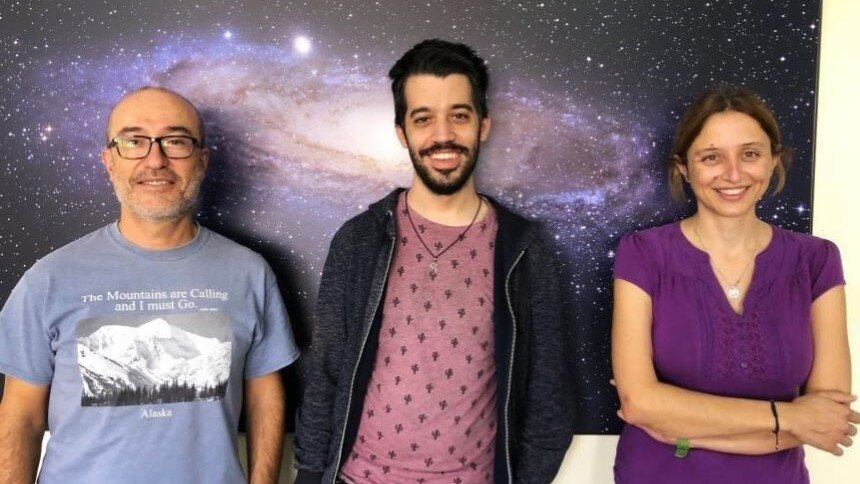The Computational Cosmology research group of the University of Valencia and linked to the Astronomical Observatory, located in the scientific-academic area of the University of Valencia Science Park, has just provided new clues for the observation and quantification of dark matter in the Universe. The work lays the theoretical foundations for the search of a new observational effect: the relation between the intensity of accretion shocks and the amount of dark matter. The proposed idea implies a new constraint to the current cosmological model, according to the article published by this scientific team in Nature Astronomy
Dark matter is a key piece of the cosmological model for understanding the Universe. Within the currently accepted paradigm, the physical nature of 85% of the matter in the Universe is a mystery, since it is not possible to see or detect it directly. Hence it is called 'dark matter'. In the meantime, the current indirect methods of detection have significant uncertainties. At present, dark matter is identified from the gravitational force it exerts on ordinary matter, which is observed and measured using telescopes and other astrophysical tools.
The method proposed by the team is based on the analysis of a computational simulation that covers a large volume of the Universe, including galaxy clusters and the gigantic shock waves produced during their formation, i.e., the so-called 'accretion shocks'. Specifically, the work shows that the total mass of the clusters, the radius of the accretion shock and the intensity of the accretion shock are closely related. "These shock waves are a consequence of the strong deceleration and subsequent heating of ordinary matter, which reaches supersonic speeds due to the gravitational action generated by dark matter," explains physicist David Vallés Pérez, researcher of the UV Talent Attraction program at the Department of Astronomy and Astrophysics, and first author of the article. "The method we propose will allow us to measure the total mass of the cluster, 85% of which we know corresponds to dark matter," adds Vallés.
“Cosmological simulations play the role of large virtual laboratories in which to recreate and study the different physical processes that determine the formation and evolution of the Universe. In this sense, simulations have been a key tool for the advancement of our vision of the Cosmos”, Vicent Quilis, Professor of Astronomy and Astrophysics, head of the Computational Cosmology group and co-signer of the work
Thus, the result of this work opens the door to the establishment of a new, more precise and reliable scientific method for the study of dark matter, a fundamental factor for the cosmological model of the Big Bang. "Despite the challenge of measuring the properties of the gas around the outermost shock waves, some preliminary data allow us to expect that, in the coming years, different observational projects in X-rays and millimeter waves will be able to measure the radius and intensity of the accretion shocks for a large number of galaxy clusters," says Susana Planelles, full professor at the Department of Astronomy and Astrophysics, co-director of the study and co-signer of the paper. "And these direct measurements will allow us to apply the method we propose to estimate the dark matter content of the clusters," adds the researcher, who belongs to the Computational Cosmology group responsible for the research.
To develop this study, the team has used the 'Lluís Vives' supercomputer, a hybrid system of shared and distributed memory with more than ten thousand calculation cores, which is part of the supercomputing network of the University of Valencia. "Cosmological simulations play the role of large virtual laboratories in which to recreate and study the different physical processes that determine the formation and evolution of the Universe. In this sense, simulations have been a key tool for the advancement of our vision of the Cosmos", explains Vicent Quilis, Professor of Astronomy and Astrophysics, head of the Computational Cosmology group and co-signer of the work.
The results of this study are derived from the ongoing doctoral thesis of David Vallés - directed by Vicent Quilis and Susana Planelles - and will imply, according to the article, a new constraint to the current cosmological model, which estimates the amount of dark matter in the Universe at 85%. "We hope that the application of the method we describe will make it possible to use a whole new generation of very useful observational data to determine the components of the Universe and thus contribute to improving the cosmological model that helps us understand the formation and evolution of the Cosmos," concludes Quilis.
Cosmic accretion shocks as a tool to measure the dark matter mass of galaxy clusters. David Valles-Pérez, Vicent Quilis and Susana Planelles. NATURE Astronomy 2024. https://doi.org/10.1038/s41550-024-02303-x
Recent Posts


